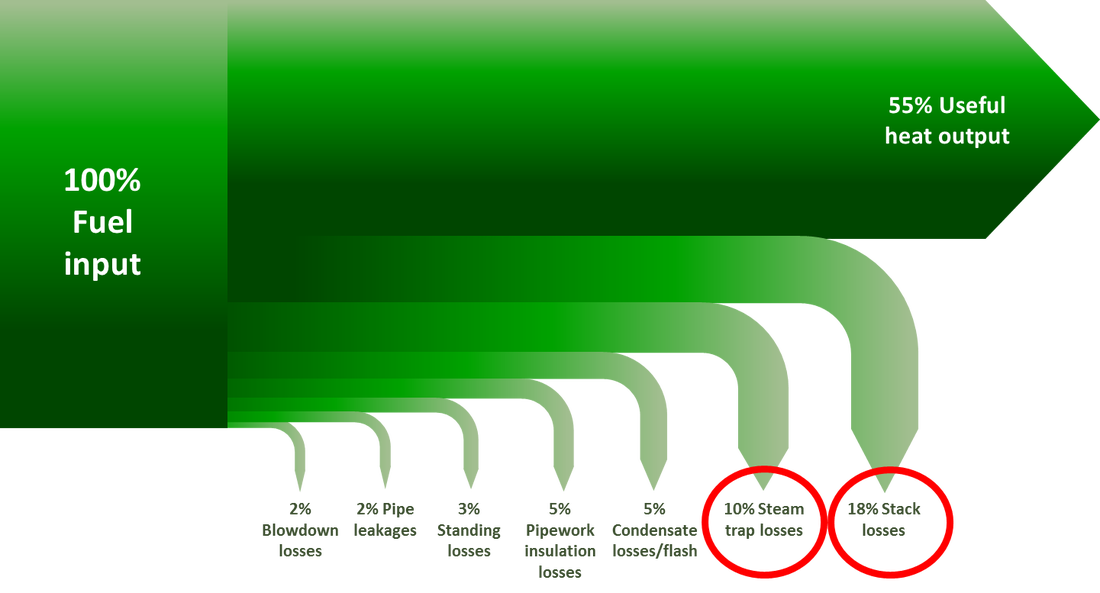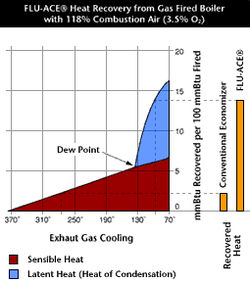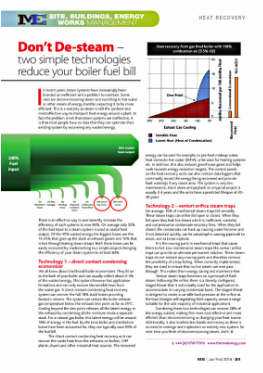 In recent years, steam systems have increasingly been branded as inefficient and a problem to maintain. Some sites are decommissioning steam and switching to hot water or other means of energy transfer, expecting it to be more efficient. This is a real pity as steam is still the quickest and most effective way to transport heat energy around a plant. In fact the problem isn’t that steam systems are not effective, it is that most people have no idea that they can optimize their existing system by recovering any wasted energy. There is an effective way to permanently increase the efficiency of such systems to over 80%. On average only 55% of the fuel Input to a steam system is used as useful heat output. Of the 45% wasted energy the biggest losses are the 15-25% that goes up the stack as exhaust gasses and 10% that is lost through leaking steam straps. Both these losses can be easily recovered by implementing two simple projects bringing the efficiency of your steam system to at least 83%.  Technology 1 – Direct Contact Condensing Economizer We all know about traditional boiler economizers. They fit on to the back of your boiler and can usually collect about 2-4% of the wasted energy. This system however has application limitations and can only recover the sensible heat from the waste gas. A Direct Contact Condensing heat recovery system, such as FLU-ACE, can recover the full 18% stack losses providing fantastic returns. The system can reduce the boiler exhaust gas temperature below the exhaust dew point as far as 25°C. Cooling beyond the dew point releases all the latent energy in the exhaust by condensing all the moisture inside a separate stack. For a natural gas boiler, this latent energy will be around 18% of energy in the fuel. By the time boiler and distribution losses have been accounted for, they can typically save 20% of the fuel bill. FLU-ACE can recover the waste heat from the exhausts on boilers, CHP plants, dryers and other industrial heat sources. The recovered energy can be used for example, to pre-heat makeup water, heat Domestic Hot Water (DHW), or be used for heating systems etc. In addition, this also reduces greenhouse gases and helps work towards energy reduction targets. The control panels on the heat recovery units can also contain data loggers that continually record the energy being recovered and provide fault warnings if any issues arise. The system is very low maintenance, stand alone and payback on a typical project is usually 2-3 years and the units have a predicted lifespan of 20-30 years. Technology 2 – Venturi Orifice Steam Traps On average, 10% of mechanical steam traps fail annually. These steam traps can either fail open or closed. When they fail open they leak live steam which is inefficient, wasteful and can pressurise condensate recovery lines. When they fail closed, the condensate can back up causing waterhammer and if not detected quickly, can be catastrophic causing pipework to erode, and at times explode. It is the moving parts in mechanical traps that cause them to fail. Low maintenance steam traps like our venturi orifice GEM traps can provide an ultimate permanent solution. These steam traps do not contain any moving parts and therefore remove the possibility of a trap failing. When correctly implemented, they are sized to ensure that no live steam can ever pass through. This makes them energy saving and maintence free. Venturi steam traps functions on a principal of flash steam. Following the orifice there is a cleverly configured staged throat that is individually sized for the application to accommodate its varying condensate loads. The staged throat is designed to create a variable back pressure at the orifice as the load changes self-regulating their capacity across a range suitable for the vast majority of industrial applications. Combining these two proven technologies can recover 28% of the energy wasted. Making this more cost effective and more efficient then decommission or changing your heat source. Not only is this more efficient but it also involves less time hassle and money as there is no need to redesign and implement an entirely new system. So next time you think of decommissioning steam, don’t. Contact us instead.
1 Comment
A large amount of the heat supplied by most fuel-fired heating equipment is wasted as exhaust or flue gases. In furnaces, air and fuel are mixed and burned to generate heat, some of which is transferred to the heating device and its load. When the heat transfer reaches its practical limit, the spent combustion gases are removed from the furnace via a flue or stack. At this point, these gases still hold considerable thermal energy. In many systems, this is the greatest single heat loss. The energy efficiency can often be increased by using waste heat gas recovery systems to capture and use some of the energy in the flue gas. Heat Recovery 101: Exhaust gas loss or waste heat depends on flue gas temperature and its mass flow, or in practical terms, excess air resulting from combustion air supply and air leakage into the furnace. The excess air can be estimated by measuring oxygen percentage in the flue gases. Waste Heat Recovery Heat losses must be minimized before waste heat recovery is investigated. The most commonly used waste heat recovery methods are preheating combustion air, steam generation and water heating, and load preheating. Preheating Combustion Air A recuperator is the most widely used heat recovery device. It is a gas-to-gas heat exchanger placed on the stack of the furnace that preheats incoming air with exhaust gas. Designs rely on tubes or plates to transfer heat from the exhaust gas to the combustion air and keep the streams from mixing Another way to preheat combustion air is with a regenerator, which is an insulated container filled with metal or ceramic shapes that can absorb and store significant thermal energy. It acts as a rechargeable storage battery for heat. Incoming cold combustion air is passed through the regenerator. At least two regenerators and their associated burners are required for an uninterrupted process: one provides energy to the combustion air while the other recharges. Steam Generation and Water Heating These systems are similar to conventional boilers but are larger because the exhaust gas temperature is lower than the flame temperature used in conventional systems. Waste heat boilers can be used on most furnace applications, and special designs and materials are available for systems with corrosive waste gases. Plants that need a source of steam or hot water can use waste heat boilers, which may also work for plants that want to add steam capacity. However, the waste boiler generates steam only when the fuel-fired process is operating. Load Preheating If exhaust gases leaving the high temperature portion of the process can be brought into contact with a relatively cool incoming load (the material being heated), energy will be transferred to the load, preheating it and reducing the energy consumption. Load preheating has the highest potential efficiency of any system that uses waste gases. Load preheating systems can be difficult to retrofit and are best suited for continuous rather than batch furnaces. Benefits include:
Potential Applications
Waste heat recovery should generally be considered if the exhaust temperature is higher than 1,000°F, or if the flue gas mass flow is very large. Contact us today to learn more about how a FLU-ACE direct contact condensing heat recovery system can help your business lower its fuel costs and reduce its carbon emissions. |
Archives
August 2021
Categories
All
|


 RSS Feed
RSS Feed